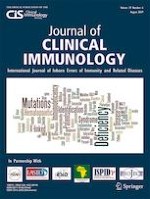Erschienen in:

11.06.2019 | Original Article
Respiratory Complications in Patients with Hyper IgM Syndrome
verfasst von:
Bobak Moazzami, Reza Yazdani, Gholamreza Azizi, Fatemeh Kiaei, Mitra Tafakori, Mohammadreza Modaresi, Rohola Shirzadi, Seyed Alireza Mahdaviani, Mahsa Sohani, Hassan Abolhassani, Asghar Aghamohammadi
Erschienen in:
Journal of Clinical Immunology
|
Ausgabe 6/2019
Einloggen, um Zugang zu erhalten
Abstract
Purpose
Hyper Immunoglobulin M (HIgM) syndrome is a heterogeneous group of primary immunodeficiency disorders, characterized by recurrent infections and associated with decreased serum IgG and IgA, but normal or increased IgM. The aim of the present study was to evaluate respiratory manifestations in patients with HIgM syndrome.
Methods
A total number of 62 patients, including 46 males and 16 females were included in the present study. To investigate the respiratory complications among HIgM patients, we evaluated the clinical hospital records, immunologic and molecular diagnostic assays, pulmonary function tests (PFT), and high-resolution computed tomography (HRCT) scans.
Results
Pneumonia was the most common respiratory manifestation (n = 35, 56.4%), followed by otitis media (45.1%), sinusitis (33.8%), and bronchiectasis (14.5%). 52.1% of the patients had abnormal PFT results, with a predominant restrictive pattern of changes. HRCT scans demonstrated abnormal findings in 85.7% of patients with found mutations. Ten cases had hilar lymphadenopathy and para-hilar infiltrates in their HRCT findings. Genetic diagnosis was confirmed in 29 HIgM patients (72.4% CD40 ligand (CD40L) and 24.1% activation-induced cytidine deaminase (AICDA/AID) deficiencies). Majority of patients with CD40L (71.4%) and AID (57.1%) deficiencies had missense mutations. Pneumonia and abnormal high-resolution computed tomography (HRCT) findings were more frequent among patients with CD40L mutation. Respiratory failure constituted the major cause of mortality (37.5%) with majority of cases occurring in CD40L-deficient patients (50%).
Conclusions
Respiratory complications are common in patients with HIgM syndrome. A proper awareness of respiratory manifestations in patients with HIgM may result in improved management, reduced morbidity and mortality, and an improvement in the quality of life of the patients.